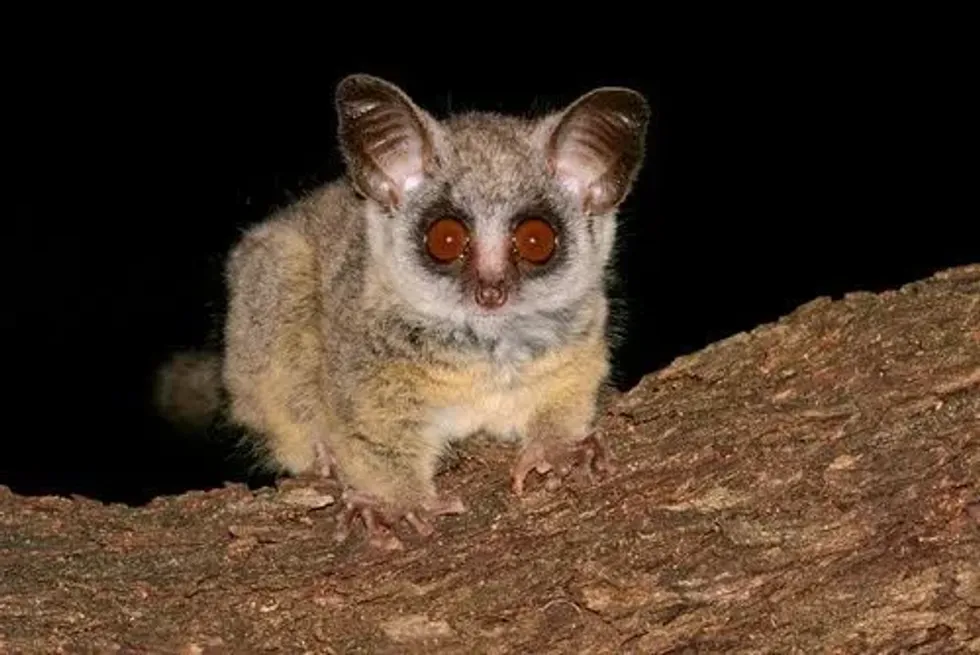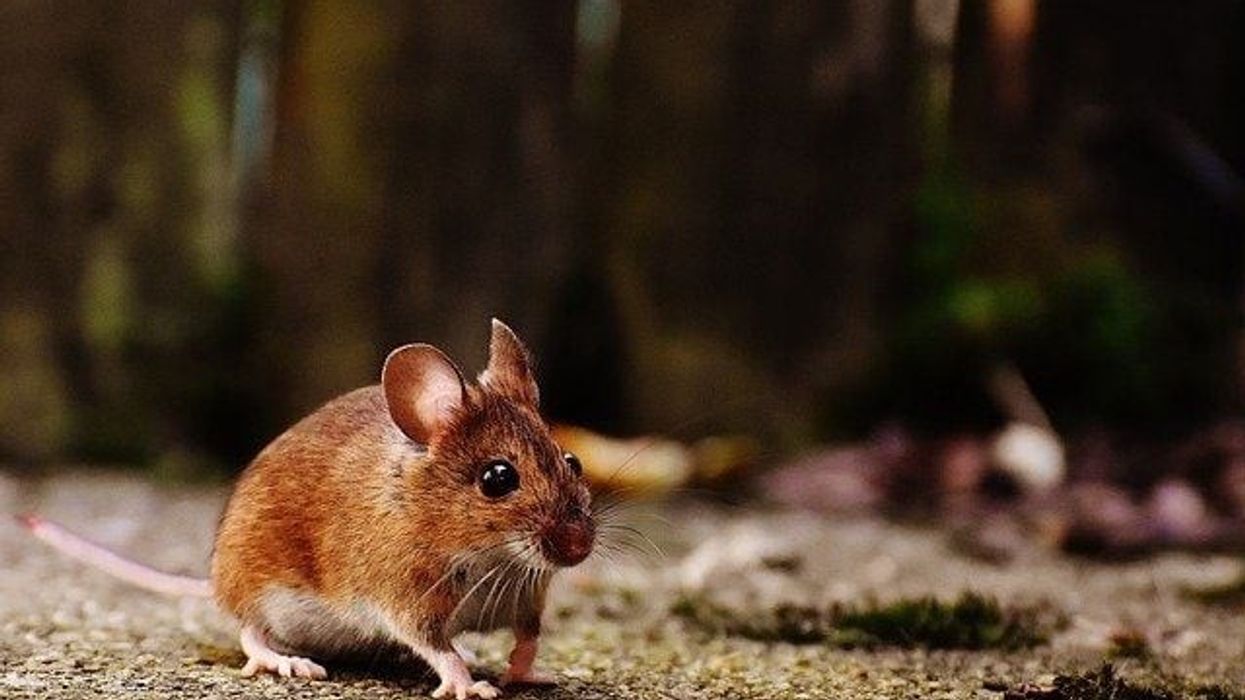The lesser bushbaby, also known as the Senegal bushbaby, the Senegal galago, or the lesser galago is one of the smallest, most gregarious, scansorial, motile, sedentary, and nocturnal primates of the galago genus and Galagidae family of the kingdom of Animalia.
It is believed that there are more than 20 known species of bushbaby (galago) worldwide, but the exact number of lesser bushbabies has not yet been recorded.
They are found in most of Sub-Saharan Africa and range from Senegal east to Somalia, south to South Africa, and are present in almost every country in between.
The lesser bush babies are terrestrial primates and their habitat includes drier areas, like savanna, woodlands, montane forests, tree hollows, bushlands, but are also found in riverine habitats, rain forests, and scrub forests.
One of the interesting facts about the lesser bushbabies is that the male bushbaby has a larger home range than the female bushbaby.
The males and females are arboreal feeders, and their varied seasonal food diet includes grasshoppers, small birds, eggs, fruits, seeds, grains, plant fluids, parts of a tree, insects, and flowers.
However, the lesser bushbabies fall prey to snakes, small cats, and owls. The lesser bushbaby (galagos) has a thick, woolly, long, silvery gray, and wavy fur which is lighter underneath.
It also has large ears, cartilaginous protuberance underneath its fleshy tongue, four transverse ridges, flat disks of thickened skin near the ends of the fingers and toes, which helps it in grasping tree limbs and slippery surfaces, and a lot of increased muscle mass in its hind leg, helping it to perform larger leaps.
They are polygynous breeders, and the males have to compete for the females and access their home ranges. Their breeding season occurs twice a year, once in November, and then in February.
The gestation period lasts for four months and the female builds a nest out of leaves in which they give birth and nurse their young, for three to four months.
The average litter size is one to three eggs, born between April and November.
The role of the males in parenting has not been established yet, and the young bushbabies cling to the females, where she picks them up with her hands or mouth, especially for the first three days, after which she leaves them unattended when foraging.
The lesser bushbabies grow rapidly and the female species reaches sexual maturity in 240 days, whereas it takes a male species 300 days to reach the same.
These African bush babies have up to 18 different vocalizations, and they produce loud, shrill cries, despite their small size, through which they communicate with each other. These cries are similar to those of human babies.
They also produce croaking, shrill whistles, chattering, or clucking sounds in case of danger. They also use a variety of facial expressions to communicate their emotional states, such as aggression, fear, and affiliation.
They also like to mark their territory by urinating on their hands and spreading their scent. Although the bushbabies evolved before the monkeys, the two of them are related to each other as they are both primates.
The bushbabies are called nagapies, which means night monkeys in Afrikaans. There is no sex-specific name given to the males and females lesser bushbabies.
These galago species are both known by their scientific name, Galago senegalensis.
They are extremely cute, with their small body, hind legs, long ears, and large appealing eyes. The lesser bushbabies can live up to 14 years in captivity.
However, due to its predators, the life span of lesser bush babies gets reduced to three to four years in the wild. They are one of the most successful primates of southern Africa, and according to the International Union for Conservation of Nature (IUCN) Red List of Threatened Species, their conservation status is of Least Concern.
The lesser galago is found at the bushmeat markets, but it is not hunted or consumed by humans. However, they are sold as pets for human entertainment.
For more relatable content, check out these bush baby facts and spicebush swallowtail facts!
Lesser Bush Baby Interesting Facts
What type of animal is a lesser bush baby?
The lesser bush baby is one of the smallest South African nocturnal primate animals of the Galago species of the Galagidae family and the Galago genus.
What class of animal does a lesser bush baby belong to?
The lesser bushbaby belongs to the Mammalia class of the kingdom of Animalia.
How many lesser bush babies are there in the world?
It is believed that there are more than 20 known species of bushbaby (galago) worldwide, but the exact number of these African lesser bushbabies has not been recorded yet.
Where does a lesser bush baby live?
Lesser galagos are found in most of Sub-Saharan Africa and Central Africa and they range from Senegal east to Somalia, down to South Africa, and are present in almost every country in between.
What is a lesser bush baby's habitat?
The lesser bushbaby is one of the terrestrial primates and its habitat includes drier areas, like savanna, montane forest, woodlands, tree hollows, bushlands, but it is also found in riverine habitats, rain forests, and scrub forests.
Who does lesser bush baby live with?
The lesser bushbaby (galago senegalensis) lives with its family but splits in search of food during dusk.
How long does a lesser bush baby live?
The lesser galagos can live up to 14 years in captivity. However, due to its predators, the life span of lesser bush babies gets reduced to three to four years in the wild.
How do they reproduce?
The Senegal galagos (galago senegalensis) are polygynous breeders, and the males have to compete for the females and access to their home ranges.
Their breeding season occurs twice a year, once in November, and then in February.
The gestation period lasts for four months and the female species build a nest out of leaves in which they give birth and nurse their young, for three to four months. The average litter size is one to three eggs, born between April and November.
The role of the males in parenting has not been established yet, and the young bushbabies cling to the female species, where she picks them up with her hands or mouth, especially for the first three days, after which she leaves them unattended when foraging.
The lesser bushbabies grow rapidly and the female reaches sexual maturity in 240 days, whereas it takes a male 300 days to reach the same.
What is their conservation status?
Lesser bushbabies are one of the most successful primates of southern Africa, and according to The International Union for Conservation of Nature (IUCN) Red List of Threatened Species, their conservation status is of Least Concern.
Lesser Bush baby Fun Facts
What does a lesser bush baby look like?

The lesser bushbaby (galagos) has thick, woolly, long, silvery gray, and wavy fur which is lighter underneath.
It also has large ears, cartilaginous protuberance underneath its fleshy tongue, four transverse ridges, flat disks of thickened skin near the ends of the fingers and toes, which helps it in grasping tree limbs and slippery surfaces, and a lot of increased muscle mass in the hind legs, helping it to perform larger leaps.
How cute are they?
These small primate animals are extremely cute, with their small body, hind legs, long ears, and large appealing eyes.
How do they communicate?
These African bush babies have up to 18 different vocalizations, and they produce loud, shrill cries, despite their small size, through which they communicate with each other. These cries are similar to those of human babies.
They also produce croaking, shrill whistles, chattering, or clucking sounds in case of danger. They use a variety of facial expressions to communicate their emotional states, such as aggression, fear, and affiliation. They also like to mark their territory by urinating on their hands and spreading their scent.
How big is a lesser bush baby?
The lesser bushbabies are small primates with an average length of 5.12 in (130 mm), and their tail length varying between 0.59-1.61 in (15-41 mm). It is almost five times smaller than a howler monkey.
How fast can a lesser bush baby run?
These African bushbabies can cover up to 29.5 ft (9 m) in seconds, due to their extremely powerful back leg muscles, though we do not know their exact speed.
How much does a lesser bush baby weigh?
The average weight of the lesser bushbabies falls between 0.21-0.66 lb (95-300 g). However, a newborn weighs less than 0.03 lb (13.6 g).
What are the male and female names of the species?
There are no sex-specific names for male and female lesser bush babies.
What would you call a baby lesser bush baby?
The baby lesser bush babies are called pups.
What do they eat?
They are arboreal feeders, and their varied and seasonal diet includes grasshoppers, small birds, eggs, fruits, seeds, grains, plant fluids, parts of a tree, insects, and flowers. Their predators are snakes, small cats, and owls.
Are they dangerous?
No, lesser bush babies are not considered to be a danger to humans.
Would they make a good pet?
Yes, lesser bush babies are often kept as pets in Africa, due to their general fluffiness and their large appealing eyes.
Economic Importance for Humans: Positive
The lesser galago is found at the bushmeat markets, but it is not hunted or consumed by humans. However, they are sold as pets for human entertainment.
Did you know...
There are four subspecies of bushbabies and they are all native to African countries.
The lesser bush baby is losing living space due to the growing human populations, the increase in agricultural production, and the construction of new roads.
The male bush baby has a larger home range than the female bush baby.
Are lemur and bushbaby the same?
No, a lemur is a colloquial primate, native to Madagascar and some surrounding islands, whereas the bush baby is small, nocturnal, and native to mainland Africa. However, they both belong to the prosimian group of primates.
Are bush babies related to monkeys?
Although the bushbabies evolved before the monkeys, the two of them are related to each other as they are both primates. Bush babies are called nagapies, which means night monkeys in Afrikaans.
Here at Kidadl, we have carefully created lots of interesting family-friendly animal facts for everyone to discover! Learn more about some other mammals including North American black bear facts or western lowland gorilla facts pages.
You can even occupy yourself at home by coloring in one of our free printable lesser bush baby coloring pages.
Second image by Wegmann.









